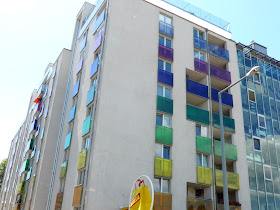
Currently at the Vancouver Museum there is a display on social housing in Vienna. Titled 'Red Vienna', since the 1920s the city has been building social housing for a very substantial percentage of the population. To learn more, you can go here:
https://museumofvancouver.ca/exhibitions/exhibit/vienna-model-housing-21st-century-city
As I traveled around the city, I noticed many of these buildings. They are distinguished by their modest design and naming, along with the architect and date. There are lessons here for Vancouver.
Many people think Vancouver should emulate Vienna and increase the percentage of population living in government housing. While I understand this sentiment, and agree that the private sector, on its own cannot produce truly affordable housing, Vienna has been building affordable housing for the masses for almost 100 years; it's part of the city's tradition and tax structure. It's not going to happen in Vancouver over the short term. But we should have the discussion.
I was also intrigued by some of the newer, more expensive single family and multi-family housing I came across during my travels. Below are a few photos of earlier projects, some of which are not being renovated and 'greened', and examples of new housing around Vienna.

 |
| Literally greening the building! |
 |
| I was intrigued by these glass walls that had been installed between a number of older social housing projects. They seemed to be too elaborate to be simply sound screens and that's because they are much more. According to Andreas Lindinger, "I just researched the glass noise barriers at Theodor-Koerner-Hof
municipal apartment complex near Margaretenguertel and indeed those are
noise barriers with integrated photovoltaic modules! See http://www.ertex-solar.at/media/projekte/Wien_Energie.pdf and https://www.wienenergie.at/eportal3/ep/channelView.do/channelId/-48413 (in
German). It was built in 2007 and is the highest noise barrier with
integrated PV in Vienna with 18m height and 150m length. It has a
maximum capacity of 13.4 kWp and 190 m2 of PV panels which produces
9,380 kWh electricity per year and it cost EUR 3.5m." |
Some of the more modern housing is not dissimilar to what one finds in many other European cities, or North American cities for that matter.
 |
| I discovered these modern new apartments on a visit to the wine taverns described in a future post. |
 |
| Yes, this was designed by who you think it was. Student housing at the university |
 |
| An attractive new condominium project, enhanced by the protruding balconies |
 |
| Throughout Europe simple new, boxy buildings are enhanced by the use of coloured glass balconies. I saw a lot of this in Scandinavia last year. |
 |
| I personally am troubled by the expense of these 'double skinned' glass buildings. But they are increasingly popular. What they don't offer in my view is 'an economy of means'! |
 |
| I'm sure there was a bit of a battle before this was approved. Must have been a friend of the mayor or president! |
 Currently at the Vancouver Museum there is a display on social housing in Vienna. Titled 'Red Vienna', since the 1920s the city has been building social housing for a very substantial percentage of the population. To learn more, you can go here: https://museumofvancouver.ca/exhibitions/exhibit/vienna-model-housing-21st-century-city
Currently at the Vancouver Museum there is a display on social housing in Vienna. Titled 'Red Vienna', since the 1920s the city has been building social housing for a very substantial percentage of the population. To learn more, you can go here: https://museumofvancouver.ca/exhibitions/exhibit/vienna-model-housing-21st-century-city


















No comments:
Post a Comment